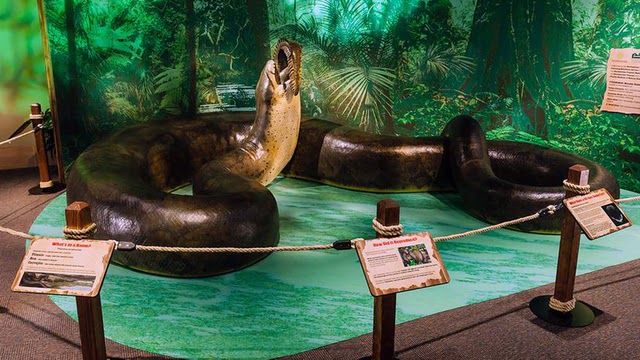Quck answer
The Titanoboa is an extinct species of snake that lived about 60 million years ago, during the Paleocene epoch. It was the largest snake ever discovered, reaching lengths of up to 43 feet and weighing over a ton. The Titanoboa ruled the Colombian rainforest, which was much warmer and wetter during the Paleocene than it is today. Its diet consisted of giant turtles and crocodiles, making it a top predator in its ecosystem. The discovery of the Titanoboa has helped scientists better understand the evolution of snakes and the ancient climate of South America.
Extinct Animals

65.5 million years ago, when the dinosaurs became extinct, other reptilian lineages also died out, marking one of the greatest mass extinction events of all time. However, the Cenozoic era, also known as the “Age of Mammals”, saw the rise of giant reptiles, such as the colossal Titanoboa cerrejonensis, which made modern pythons and anacondas look small.
Ancient Discoveries in CerrejГіn
CerrejГіn, a vast coal mine in northern Colombia, has yielded thousands of Cenozoic fossils, including those of Titanoboa. The fossils are approximately 58 million years old and represent various exotic plants, river fish, crocodile-like predators and giant turtles. These fossils indicate that the area was tropical and swampy, similar to the Amazon River Delta today. Titanoboa, the largest snake to have ever roamed Earth, was a predator in this environment.
What We Know About Titanoboa
Although a complete skeleton of Titanoboa has yet to be found, fossils from 28 of these giant snakes have been recovered at CerrejГіn. Comparing the fossils to the bones of living snakes has allowed scientists to determine that Titanoboa was a boid, a family of snakes typically found in the Americas. Titanoboa was nonvenomous and killed by constriction. Its closest living relative is probably the red-tailed boa, which can grow up to 13.2 feet (4 meters) long. The largest modern snake is the South American green anaconda, which can weigh up to 440 pounds (200 kilograms) and reach a length of 27.2 feet (8.3 meters).
Titanoboa, a giant snake that lived during the Paleocene era, was the biggest snake known to science, with an estimated length of 42 to 47 feet and a possible weight of 1.25 tons. This massive predator was longer than the Tyrannosaurus rex and could easily consume crocodylians. The Smithsonian’s life-sized sculpture of Titanoboa, which showed the snake devouring a crocodylian, was displayed in New York’s Grand Central Station in 2012. Titanoboa probably spent a great deal of time in water, like the green anaconda, and may have had a fish-centric diet, making it the only boid on record with this type of diet. The discovery of Titanoboa was cited as evidence that the Paleocene era had a much hotter climate than today. However, other large reptiles, such as Varanus priscus, lived during the Pleistocene epoch, which was colder than today’s climate.
According to new research, it’s possible that giant reptiles don’t require an extremely hot planet to survive and thrive. Instead, competition from mammals could be a bigger obstacle to their success. Despite the disappearance of species like Titanoboa, Varanus priscus, and the New Zealand gecko, their relatives still exist and continue to add diversity to our world with their unique features. Although this may be considered an “Age of Mammals,” there are still incredible reptiles living among us. Interestingly, preserved remains of legumes, bananas, and coconuts have also been discovered at the CerrejГіn site.
FAQ
1. What is the Titanoboa snake?
The Titanoboa snake is an extinct species of snake that lived around 60 million years ago. It was the largest snake ever discovered, measuring up to 42 feet in length and weighing over 2,500 pounds. It lived in the rainforests of South America during the Paleocene epoch.
2. How did the Titanoboa snake hunt?
The Titanoboa snake was a constrictor, meaning it would wrap its body around its prey to suffocate it. It likely hunted large animals such as crocodiles and turtles, using its massive size and strength to overpower them. Its jaw was also capable of expanding to swallow prey whole.
3. Why did the Titanoboa snake go extinct?
The exact reason for the Titanoboa snake’s extinction is not known. It is believed that changes in climate and habitat may have played a role, as the rainforests it lived in began to dry out and become more seasonal. Additionally, the arrival of new predators and competition for resources may have also contributed to its decline.
4. What can we learn from studying the Titanoboa snake?
Studying the Titanoboa snake can give us insights into the ancient ecosystems it lived in and the effects of climate change on species. By understanding how the snake lived and hunted, we can also gain a better understanding of the evolution of snakes as a whole.
5. Are there any modern-day snakes that are similar to the Titanoboa?
No, there are no modern-day snakes that come close to the size of the Titanoboa. The closest living relatives of the Titanoboa are anacondas and boas, which are still impressive in size but nowhere near as massive as the extinct snake.





Leave a Reply